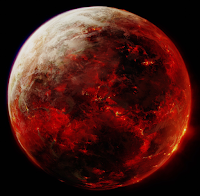Planet Classification
Classifications
Class A - Geothermal
|
Age: 0 - 2 billion years | |||||
| Class A geoactive planets are generally small, barren worlds rife with volcanic activity. This activity traps carbon dioxide in the atmosphere, causing a greenhouse effect that keeps the temperature very hot, regardless of the planet's distance from the sun. When the volcanic activity eventually ceases, the planet 'dies' and usually becomes a Class C world - a few rare cases transform into Class Q geothermal planets. Until that happens, the toxic levels of carbon dioxide make this planet unsuitable to any known life form, though silicon-based life may be able to terraform it to their needs. | |||||
Class B - Geomorteus
|
Age: 0 - 10 billion years | |||||
| Class B planets are small, mostly metallic rocky planetoids. This type of planet is usually very close to, and heated by, a parent star, featuring very little native geothermal energy. The atmosphere of these worlds is usually tenuous and features little or no chemically active particles. No lifeforms have ever been discovered on these planets. Due to the proximity to their star's destructive influence of most other materials, Class B worlds exhibit a highly iron-rich crust, with a magnetic core and no mantle. | |||||
Class C - Geoinactive
|
Age: 2 - 10 billion years | |||||
| Class C worlds are a type of planet usually in the very late stages of development that has likely evolved from another class. Essentially dead, these small, rocky worlds are generally geothermally inactive and have a cold, barren surface. As their core cooled down, their rotation slowed and eventually their atmosphere dissipated. No life form as any use for these planets, although they do often possess rich mineral deposits from their volcanically-active past. | |||||
Class D - Dwarf Planetoids
|
Age: 2 - 10 billion years | |||||
| Class D planetoids are generally smaller asteroids or moons that are locked into the gravitational pull of a larger planetary body. Class D worlds are barren and rocky, often possessing no atmosphere usually composed of metals, predominantly nickel, iron, and silicate. Animal life is unable to form on D class planetoids. Depending on their proximity to a star, a D class may be hot and arid or cold and frozen. These planets can be made habitable by terraforming as was the case with Weytahn by the Andorians during the 2050s. | |||||
Class E - Geoplastic
|
Age: 0 - 2 billion years | |||||
| Class E, or Primordial, planets represent the earliest stage in the evolution of a habitable planet. The core and crust is completely molten, making the planets susceptible to solar winds and radiation and subject to extremely high surface temperatures. The atmosphere is very thin, composed of hydrogen and helium. | |||||
Class F - Geometallic
|
Age: 1 - 2 billion years | |||||
| Class F, or Developing, planets derive from the cooling and hardening of the crust in a Class E planet. Possesses a primarily silicate-based crust, although vulcanism is still rife. Water has begun to condense to form oceans, amid centuries of constant rainfall. The atmosphere and the life that may develop on the surface are intertwined; as the rich carbon dioxide atmosphere allows early photosynthetic life to flourish, these organisms flood the atmosphere with oxygen, pushing towards the next stage in its evolution. | |||||
Class G - Geocrystalline
|
Age: 3 - 4 billion years | |||||
| Class G, or Primitive, planets derive from a Class F planet as its surface cools, volcanic activity lessens, and oxygen and nitrogen are more abundant in the atmosphere. The atmosphere is still primarily carbon dioxide released as the planet cools and crystallizes. Primitive vegetation like algae and simple animal lifeforms like sponges are able to take hold in oceans to supplement the planet's bacterial life. This is the most important step in the formation of most planets as multiple complex factors determine what class of planet will evolve next. | |||||
Planetary Zone Classification Map
Credits
Descriptions, Icons, and Map created by and used with permission from Schmidt. Information originally created/gathered for the USS Fitzgerald, Star Trek Roleplaying Game. Information concerning granting of permission can be obtained via your CO or TFCO. Should specific topic be archived, please contact the Administrator.

